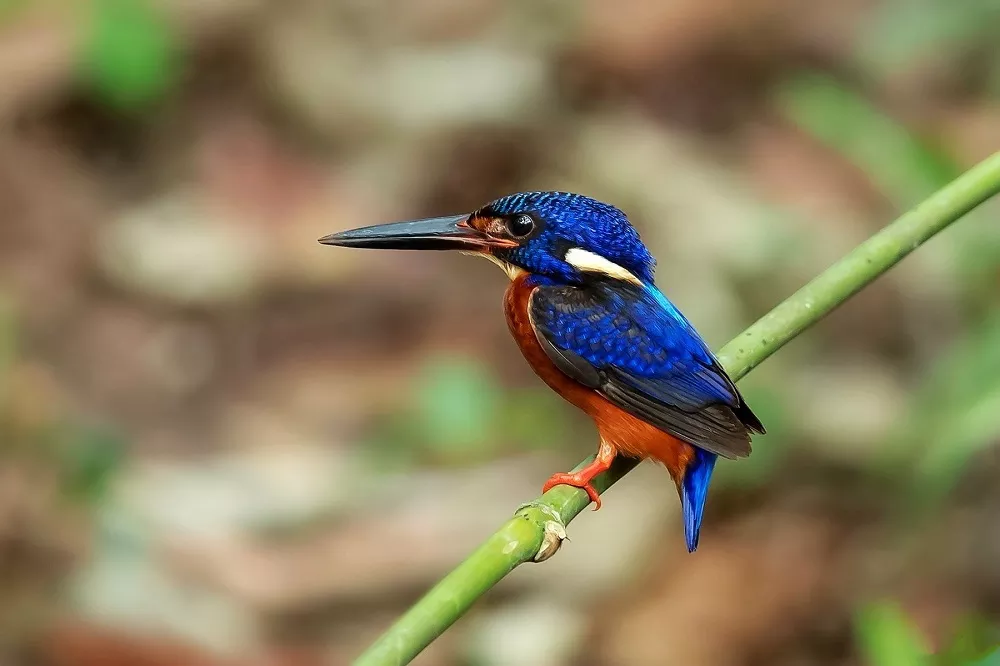The blue-eared kingfisher (Alcedo meninting) is found in Asia, ranging across the Indian subcontinent and Southeast Asia. It is a small climbing bird. The overall length is about 15 cm. The top of the head and neck are black, with blue-purple horizontal spots; the ear feathers are purple-blue; the throat is light brown; there is a yellow-white spot on each side of the neck. Blue-eared kingfisher has two types: forest dwelling and aquatic dwelling. The forest-dwelling Blue-eared kingfisher stays away from water and feeds mainly on insects. The aquatic species mainly lives in fresh waters everywhere, and likes to live and forage in ponds, swamps, and streams. The food is mainly fish, shrimp and insects. It often lives quietly on the leaves in the water and on the tree branches on the rocks near the water.
What does Blue-eared kingfisher look like
The Blue-eared kingfisher is a small bird with a body length of about 15 cm. The forehead, top of the head, and occiput of the male bird are purple-blue, densely covered with black horizontal spots. The skin is yellow first, the ear coverts and the side of the head are purple-blue. The upper back, waist and tail coverts are bright diamond blue, of which the tail coverts are darker, and the tail feathers are short and round, dark blue or black and decorated with blue. The shoulder and wing coverts are dark blue, and the wing coverts also have diamond blue spots. The flight feathers are black. The secondary flight feathers have purplish-blue feather margins, the innermost secondary flight feathers are almost all purple-blue, the inner edge is brown, and there is an oblong white or yellow-white spot on both sides of the neck. The chin and throat are white or yellowish white, and the rest of the lower body is chestnut or dark reddish brown. The plumage color of the female bird is similar to that of the male bird, but the red range at the base of the beak is larger. The iris is dark brown, the bill is black, and the legs are bright red. Iris brown; beak black (male), jaw orange (female); feet red.
The body is streamlined and most live in flight. The body surface is covered with feathers, and the forelimbs generally become wings (some species have degenerated wings); the chest muscles are developed; the rectum is short, the appetite is large, and the digestion is fast, that is, the digestive system is developed, which is helpful for weight loss and flight; the heart has two atria and two ventricles , rapid heart rate. Body temperature is constant. In addition to the lungs, the respiratory organs also have air sacs formed by the protrusion of the lung wall to help the lungs perform double respiration. oviparous. The body temperature is high, usually 42°C. There is a well-developed keel on the sternum of birds, and the skeleton is hollow and inflated, which is a characteristic of the blue-eared kingfisher’s bone structure to adapt to flying life.
Size measurement: body length 150 mm; mouth peak 33-39 mm; wing 62-69 mm; tail 25-27 mm; tarsus 8 mm.
Blue-eared kingfisher habitat
Blue-eared kingfishers are resident birds, mainly inhabiting the banks of rivers in evergreen broad-leaved forests below 1,500 meters above sea level, especially in forest streams with dense forests and rich aquatic animals. They live in streams, lakes, rivers, and fish ponds. Often solitary activities. It likes to perch on low branches along the shore.
Blue-eared kingfisher living habit
Sexually solitary, it usually lives alone on branches or rocks near the water, waiting for opportunities to hunt. Its food is mainly small fish, and it also eats crustaceans, various aquatic insects and their larvae, and also pecks small frogs and a few aquatic plants. It flies and dives to the surface of the water to catch fish and shrimp with its sharp beak. Alone or in pairs, stand on the branches or rocks near the water for a long time to observe patiently, and find small fish floating to the water surface, dive to the water surface and catch the fish with sharp beaks, and fly to the tree or rock to swallow. Dig tunnel-like burrows in sandbanks or mud cliffs in which to lay eggs and feed young birds. It likes to live and forage in ponds, swamps, and streams, and often lives quietly on the leaves in the water and tree branches on the rocks by the water. The eyes are fixed on the water surface. Once food is found, it will fly straight to catch it at lightning speed, and then return to the habitat to wait. Sometimes it flies on the water surface like a rocket, which is very beautiful.
Distribution range of Blue-eared kingfisher
Distributed in Bangladesh, Brunei Darussalam, Cambodia, China, India, Indonesia, Lao People’s Democratic Republic, Malaysia, Myanmar, Nepal, Philippines, Singapore, Sri Lanka, Thailand, Vietnam.
Mode of reproduction
The breeding season is from April to August. Nests on rocky cliffs along banks of rivers in forests. Digging their own nests. Blue-eared kingfisher can use its thick mouth to make a nest on the earth cliff, and also nest in the tunnel of the field embankment. The nest chamber is spherical. These cave birds, like woodpecker, generally do not add bedding at the bottom of the cave. . Eggs are laid directly on the nest floor. Each clutch lays 6-8 eggs. The eggs are pure white, shiny, slightly speckled, about 28 mm x 18 mm in size, 1-2 broods per year; the incubation period is about 21 days, the male and female incubate the eggs together, but only the female feeds the chicks.


 Facebook
Facebook  Instagram
Instagram  Youtube
Youtube 